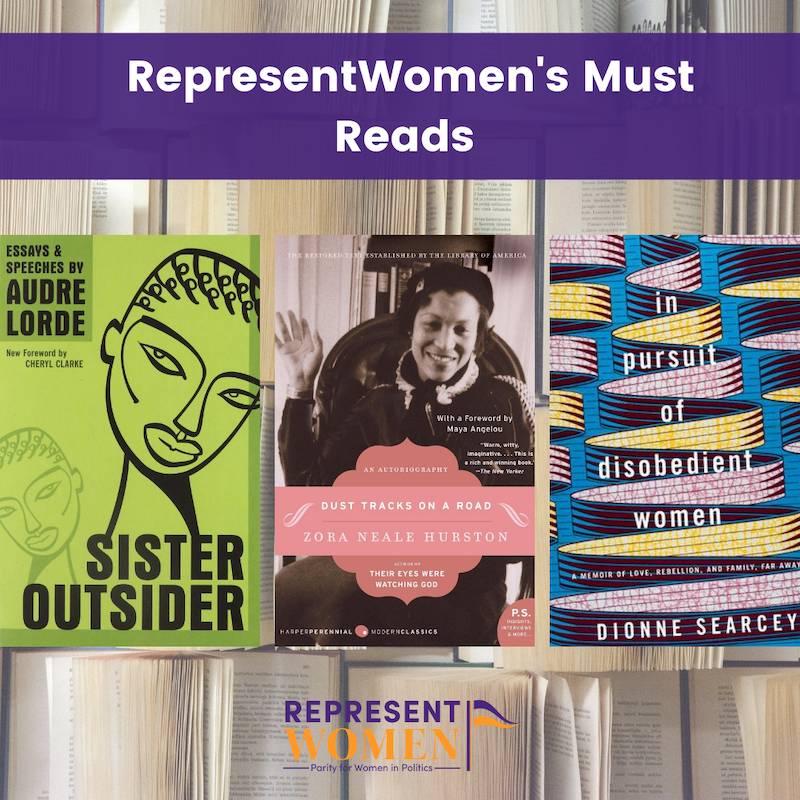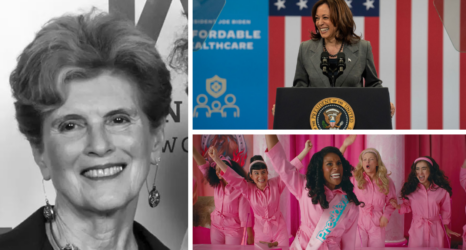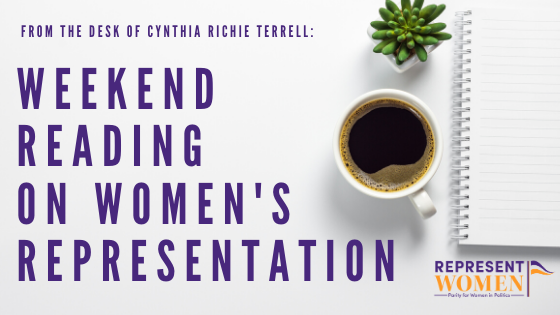
Weekend Reading on Women’s Representation is a compilation of stories about women’s representation in politics, on boards, in sports and entertainment, in judicial offices and in the private sector in the U.S. and around the world—with a little gardening and goodwill mixed in for refreshment!
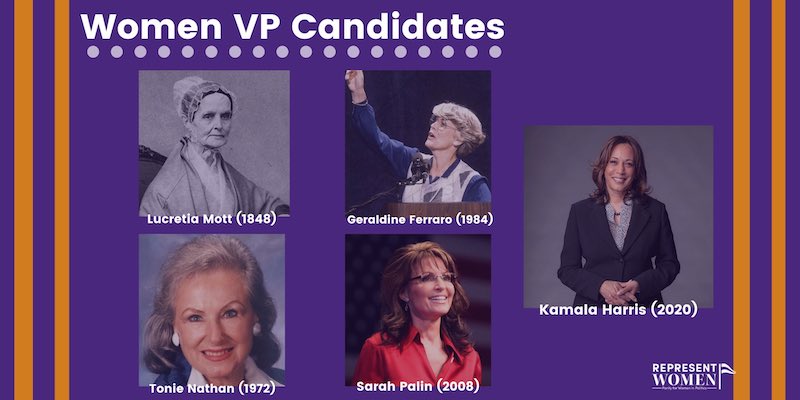
Until this week, just four women—Lucretia Mott (1848), Tonie Nathan (1972), Geraldine Ferraro (1984) and Sarah Palin (2008)—had been selected as vice presidential running mates.
Former Vice President Joe Biden’s selection of Senator Kamala Harris as his running mate brings that number to five and has led to a number of very interesting articles and news stories about this milestone in the annals of women’s history and leadership.
Of the many fabulous pieces a few stood out including this excerpt in Foreign Policy by deputy mayor of Los Angeles Nina Hachigian, entitled “Harris Is Making History, But It’s Only a First Step To Gender Parity and Racial Justice” that is part of a series of short essays:
Californians were not surprised that Joe Biden picked Kamala Harris to be his running mate. Whether as state attorney general or U.S. senator, she has won hearts and minds in this vast, diverse state with the fifth-largest economy in the world. She may not have had federal executive experience, but she has led in a state more populous than many countries. At each step of her career, she’s demonstrated her strengths of grit, brilliance, and compassion.
When Biden announced that he would pick a woman to be his running mate, it narrowed his options but plenty remained. As Los Angeles Mayor Eric Garcetti tweeted, the search committee of which he was a part vetted a number of women ready to lead the country. That makes it all the more frustrating that the U.S. national security establishment remains so male and so white. At the best of times, around 30 percent of top posts in the State Department are filled by women—with women of color few and far between—and these are not the best of times. Representation in the Department of Defense and in the military is even lower.
In the wake of the #MeToo movement and racial justice demonstrations, the lack of gender, racial, and other kinds of diversity in the foreign-policy world is garnering more attention, with a spate of articles telling hair-raising tales of sexism and racism and official reports detailing the statistics.
Groups such as Women of Color Advancing Peace and Security, Diversity in National Security, Out in National Security, the Leadership Council for Women in National Security (LCWINS, a bipartisan organization I co-founded), and others have been established to advocate for change. Research shows that diverse groups make better decisions, so these efforts are as much about improving the quality of national security policymaking as they are about fairness.
Biden and Harris—the latter when she was a candidate for president—took the LCWINS pledge to strive for gender parity in all senior national security appointments. Choosing Harris is a great first step to fulfilling that commitment. Biden has promised to go further if elected, and perhaps he will appoint women to other positions they have never had, such as secretary of defense, treasury, and veterans affairs. The first two have never been held by a person of color, either.
Though an important step, senior appointments will not be enough to overcome decades of inequality. What I have learned in politics is that to achieve gender parity and racial equity, Biden and Harris will need to implement a system of metrics, reporting, and accountability. Cabinet secretaries should have to answer personally for progress or the lack thereof in their departments.
Biden and Harris are already making history. Together they may have a chance to make even more by making U.S. diplomats and officers better reflect the country they represent.
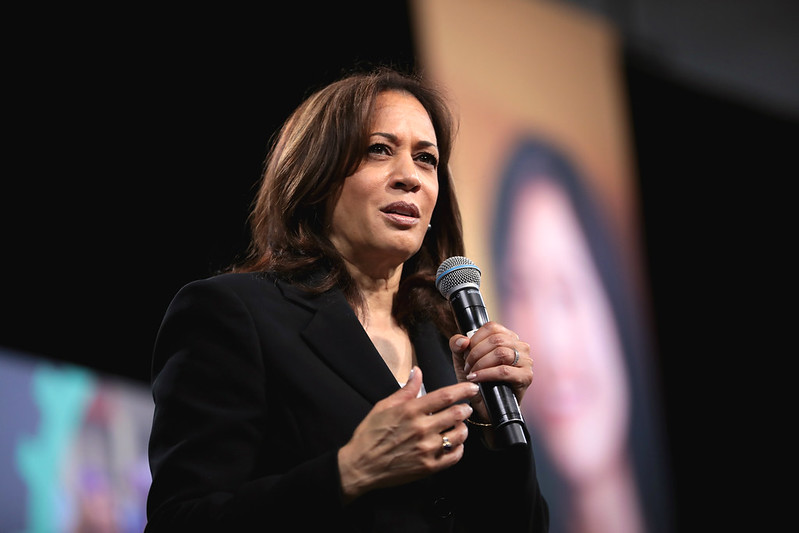
Author of Steadfast Democrats: How Social Forces Shape Black Political Behavior, Chryl Laird, wrote a powerful piece in The New York Times about Harris’s selection as VP and the history of Black women in politics in the United States:
Now comes the real, unanswerable question: Is the selection of Ms. Harris, despite her strong credentials, simply symbolic, a token gesture that will change little for Black women? Or does it truly recognize the importance of Black women for Democrats?
There is no denying this country’s political structures were not designed with marginalized groups in mind, least of all those who sit at the intersection of two marginalized communities, as Black women do. Yet their consistent support for the Democratic Party has not come about blindly; they understand the political system and where they believe they have the highest likelihood of realizing political gains for the Black community.
It is Black women, more so than any other racial-gender pair, who have gotten behind efforts at more inclusive representation with their unquestionable support for the prospect of the first woman president in 2016 and the first Black president in 2008, as well as the re-election of the first Black president in 2012.
Further, they have never hesitated to critique and challenge the party to do better by its members and what the party stands for.
Ms. Harris herself provided a good example in the primary season, when she challenged Mr. Biden’s record from the 1970s on busing. In 1964, Fannie Lou Hamer famously called out the party for its lack of inclusivity after an all-white Mississippi delegation was sent to the Democratic National Convention. Shirley Chisholm challenged the status quo of the party leadership with her 1972 presidential bid to the dismay of many Democrats.
Ms. Harris has risen to this position through her work in California, as attorney general, and in the Senate. Electorally, her appeal could motivate Black voters because, as one of their own, she offers a political lens that has a greater potential to focus the concerns for Black Americans.
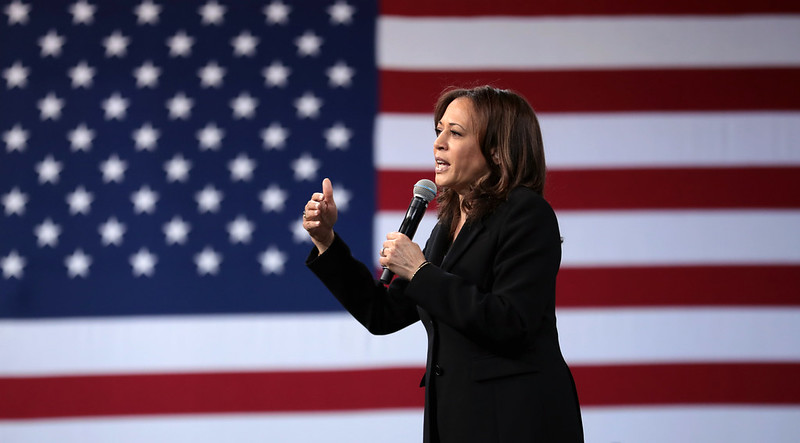
There was an interesting story in Foreign Policy by Krithika Varagur that explores the global impact of Harris’s selection:
Kamala Harris wants to “cooperate with China on global issues like climate change” but not “allow [its] human rights abuses to go unchecked.” She wants to block weapons sales to Saudi Arabia and end U.S. support for the war in Yemen but maintain the counterterrorism partnership with the kingdom. She supports a two-state solution to the Israeli-Palestinian conflict and bringing the troops home from Afghanistan, eventually.
Judged by her statements so far, the foreign-policy agenda of presumptive Democratic nominee Joe Biden’s running mate is profoundly middle of the road. That’s not surprising for a candidate who made her bones in state-level politics and has never held a foreign policy-related role, beyond membership in Senate committees like intelligence.Nevertheless, if she and Biden win the presidential election in three months—as they are heavily favored to do, as of now—and Harris becomes both the first Black woman and person of Indian descent ever in the White House, she would immediately transform America’s face to the world.
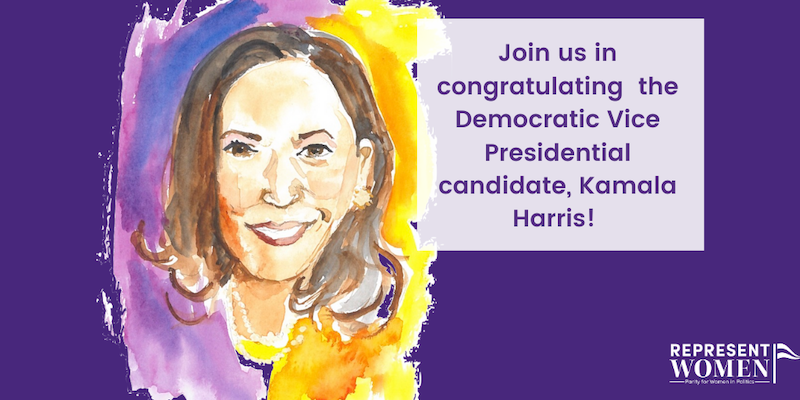
Claire Halffield researched the rules that parties use to select local level representation, state executive committees and convention delegates and wrote this terrific brief on the constitutionality of those rules:
Since the advent of women’s suffrage, political parties have implemented strategies to encourage greater political participation from women. The history of equal division rules (also known as 50-50 rules) in the United States began in the 1910s in Colorado and spread to several states before they were given national attention.
The Republican Party was the first major political party to attempt to create balance amongst their national delegations, and although this attempt failed, the party instead increased their executive committee seats from 10 to 15, with the caveat that they would “recommend reserving seven of the seats for female committee members.” The National Democratic Party’s attempt at gender balance was a doubling of their Democratic National Committee to have “one female and one male member per state.” These actions occurred in the same year as women earned the right to vote through the 19th amendment.
Subsequently, the Republican Party took on state by state fights to lobby for 50-50 statutes, and in the 1930s, the Democratic Party provided more support to this challenge. By 1950, all but eight states had equal division or party rules. However, women still did not hold bargaining power in the same way as their male counterparts. In the 1970s, the Democratic Party and Republican Party took on this issue to increase the influence of women past simple attendance and title. Due to these efforts, the Democratic Party adopted the Equal Division Rule in 1978, but the Republican party was met with more opposition.
The graphics below help to illustrate the rules that will be used at the upcoming virtual conventions.
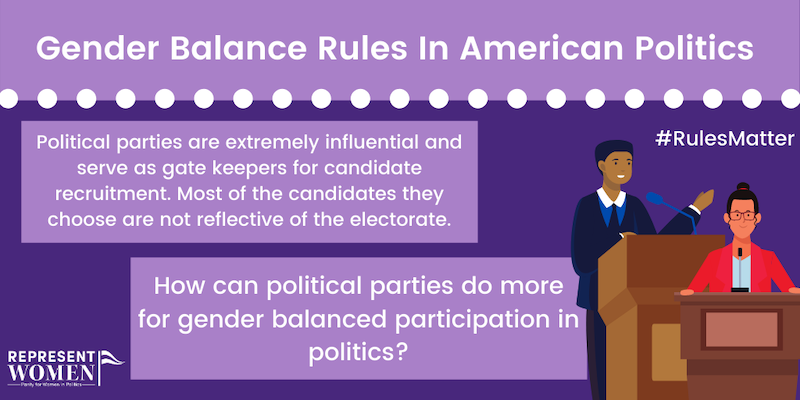
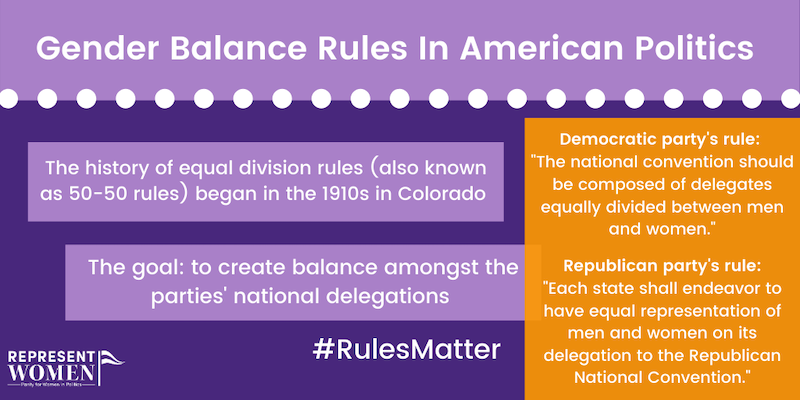
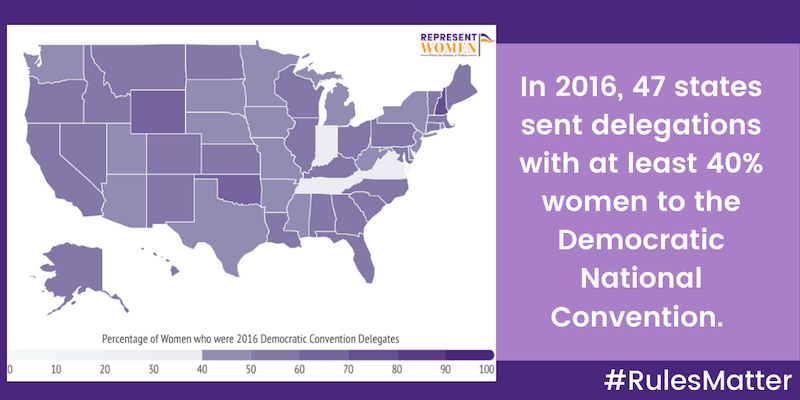
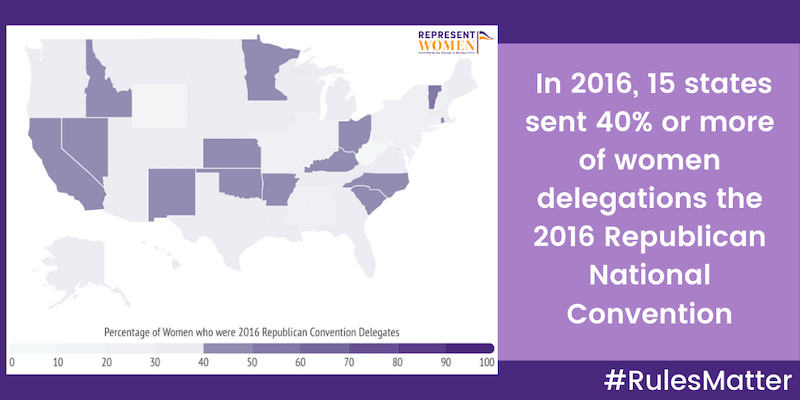
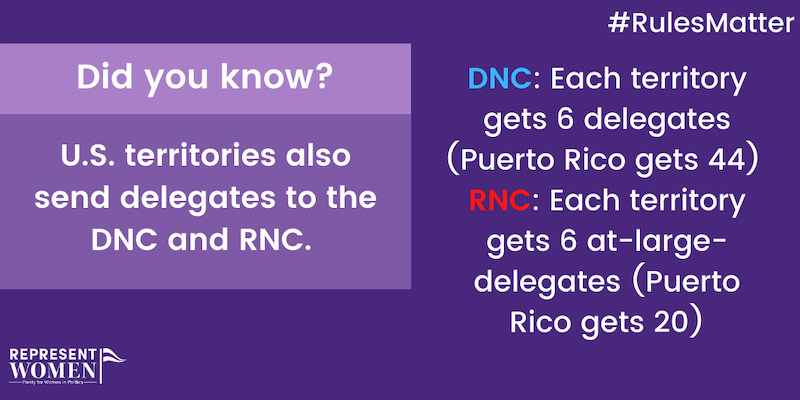
Our friends at Emerge are hosting a terrific-looking panel with Zerlina Maxwell, Dr Keisha Blain, LaTosha Brown, Glynda Carr and Ashanti Gholar at the Democratic convention entitled “The 19th at 100: Progress and the Path Forward”:
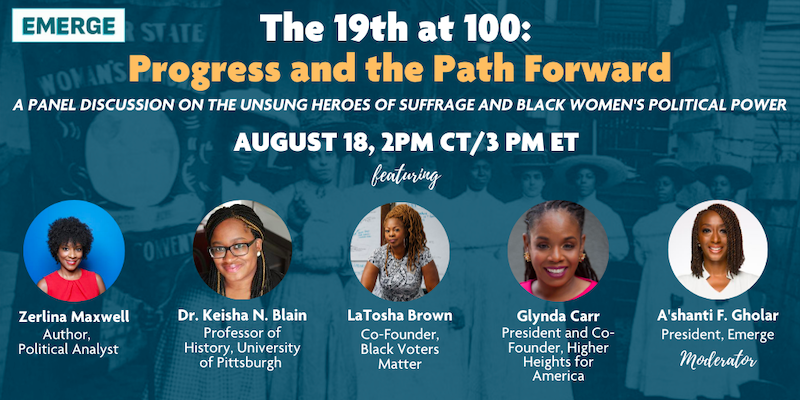
While we have come a long way since the 19th Amendment was passed 100 years ago, America still has a long way to go to achieve true equality for Black women. The 19th Amendment may have been a starting point for women’s inclusion in the political process, but the Black women who marched alongside white women during suffrage were relegated to the back and did not receive full voting rights until decades later. Today, we can clearly see the through-line from that point in history when they were excluded to the ongoing struggle for greater participation of Black women in politics, not just as voters, but also as candidates and elected officials.
This panel discussion will look back at some of the unsung heroes of the suffrage movement, examine where we are today with Black women’s representation and examine solutions to overcome barriers and build a more equitable system.
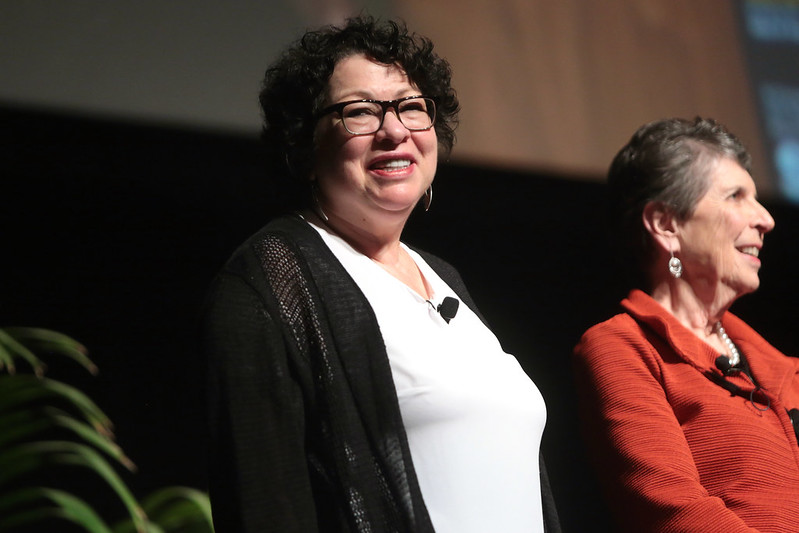
Jorge Ramos, anchor for Univision, wrote a thoughtful column for The New York Times on women’s leadership and equality:
“When I was nominated to the Supreme Court I was really scared,” Justice Sotomayor told me in Spanish. “This is a huge job. But who lives life free of fear? I have often told myself, ‘I don’t want to do this job.’” I wasn’t sure I could get it right. And I was very, very close to saying no to the president of the United States. But some friends heard that I was having second thoughts, and one of them told me: ‘Hey, Sonia, stop thinking about you. This is not about you. This is about all those little girls who will see you in that role.’”
Girls like 10-year-old Sophie, who was listening intently. At the end of the interview, as the adults looked on, she approached Justice Sotomayor to ask if she, a Latina, could one day be president of the United States. Justice Sotomayor hugged her and replied, “Yes, yes.” She then went on to give the child a true life lesson.
“First of all, a girl like you should always dream big,” Justice Sotomayor told Sophie.
“Second, never let anyone say that you can’t do it. And the minute they say that, you should do as I have done myself and say: ‘You are telling me I can’t do it? Well, I’ll show you I can.’
“Third, you have to study, study and study. That’s the only way you can achieve what you want in life. Education is the key to the future.
“And fourth, you have to work very hard. In life no one will give you anything for free. You must earn every single thing in this life. It is by studying and working hard that you will become president of the United States.”
Before saying goodbye, Justice Sotomayor hugged Sophie once again. “I hope to be alive when you become president,” the justice said, before expressing her wish to be the one to administer the oath of office to her.
I hope to be there for that occasion. But for that to happen, good intentions and hard work won’t be enough. I get why the idea of quotas isn’t very popular in the United States, a country that takes pride in presenting itself as a meritocracy. But the reality is that if we don’t set gender quotas the way Finland did, putting an end to prejudice and current inequalities will be hard. We need a sense of urgency and new rules that reflect our outrage.
Latina women face a double burden. That’s why when a Latina like Justice Sotomayor reaches one of the most important institutional positions in the country, when young dreamers achieve changes in the laws and when there is another new Hispanic senator or governor, they open the way for those who come after them.
Sophie may someday be the first Latina president of the United States; I don’t doubt it. But before that happens, many other girls like her will need to pave the way. And like Ms. Marin said, “It just doesn’t happen by itself.”
The election held in Belarus this week was marred by violence and fraud which has led to widespread protests from women, among others, who are outraged by the corrupt electoral process that pitted opposition candidate Svetlana Tikhanovskay against long-standing dictator Alexander Lukashenko.
This story on CNN captures the scene unfolding in Belarus:
Thousands of mainly female peaceful protesters clutching white flowers and balloons lined the streets of Belarus’s capital Minsk on Thursday, on the fifth day of demonstrations following the contested re-election of longtime President Alexander Lukashenko.
Authorities in Belarus say 6,700 people have been arrested and at least one person has been killed in the violent aftermath of the election, a contest that independent observers have criticized as neither free nor fair.
The opposition showed no sign of backing down despite a brutal crackdown by security forces—but it has changed strategy and tactics.
Protesters are now making their stand in a more decentralized way, amid a crowd of women lining the street holding a white ribbon. A CNN crew witnessed an almost two-mile long chain of protesters cheering on one of Minsk’s main avenues, with cars passing by and honking to show support for the opposition.
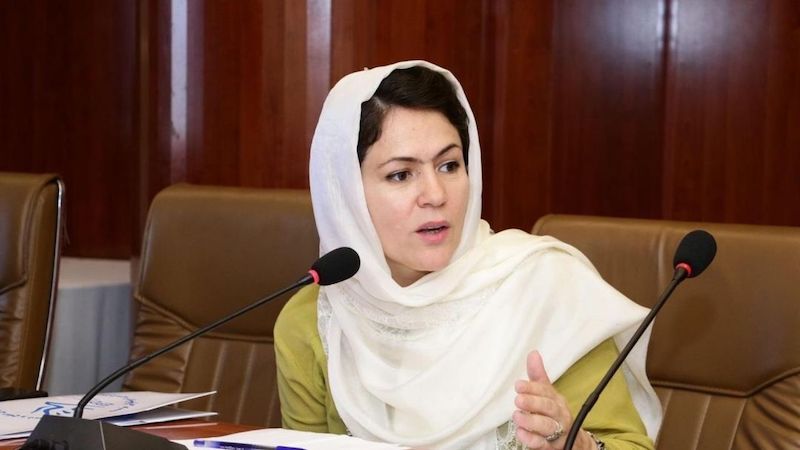
Additional global news includes this story in Behan Box by Bhanupriya Rao Sugandha Singh and Akhil Neelam about Fawzia Koofi, a woman member of the Afghan parliament:
Fawzia Koofi (45), the Member of Parliament from Afghanistan, has survived several assassination attempts by the Taliban.
“The Taliban dislike women holding such powerful positions in government as I do, and they dislike my public criticisms even more. They often try to kill me”, she writes in her memoir, ‘ The Favoured Daughter’.
Despite this, she is negotiating for peace, as one of the only two women in the pan Afghan delegation, in talks with the hardline Islamic group for the future of Afghanistan.
Throughout her life, Fawzia Koofi, has beaten the odds.
As a newborn, she survived after being left in the sun for several hours by her mother, as her conservative family which had 19 daughters from her father’s two wives, did not want another daughter. As a medical student at the top of her class, she was forced to quit studies when the Taliban took over Afghanistan in the 1990s. Soon after the fall of the Taliban regime, Koofi joined politics.
33 years after the conflict, when Afghanistan established its first elected democratic parliament in 2005, Koofi was elected to the Wolesi Jirga-the lower house of the Afghan National Assembly from Badakhshan province in Northern Afghanistan. She was elected as the first female Vice President of the National Assembly in the same year.
Fawzia Koofi could have been the first female president of Afghanistan. However, she was forced to drop out of the contest for the highest office in the country after the Election Commission changed the registration date, which disqualified her for being under the age of 40.
There was an encouraging story in The Washington Post by Ruth Eglash about four women in Israel who have made headway in politics in Israel:
One was 3 years old when she trekked out of her remote African village with her parents, ultimately bound for Israel, and another had to break loose of the strictures of her insular ultra-Orthodox Jewish world. A third had to win over the spiritual leaders of her community, and the fourth has endured a stream of insults and other abuse as a conservative Muslim wearing a headscarf.
All of these women have overcome daunting barriers to become groundbreaking members of Israel’s parliament, called the Knesset.
Thirty-three of the Knesset’s 120 members are women. And while this is not the most ever, the number includes some impressive firsts: the first Ethiopian-born Knesset member to become a government minister, the first female ultra-Orthodox Jewish lawmaker and minister, the first female Knesset member from the Druze religious community, and the first to wear a Muslim hijab.
Israel is known for its iconic female prime minister, Golda Meir, but Gayil Talshir, a political scientist at the Hebrew University of Jerusalem, said Israel has become more conservative in recent years. The central role played by ultra-Orthodox Jewish parties, which do not run women for elective office, has made the political landscape challenging for women, Talshir said.
Each of these four newly elected women represent a different sector of Israel’s society, and three of them had to look beyond the parties that traditionally represent their sectors, finding a political home instead in the Blue and White party headed by Benny Gantz, now the country’s defense minister and alternate prime minister.

Finally, for any of you who enjoyed “Parks and Recreation,” and even for those of you who haven’t watched yet, there was a clever piece by Alexis Soloski in The New York Times about Amy Poehler’s memorable character Leslie Knope:
“Parks and Recreation” was a definitive sitcom of the Obama era — optimistic, well-intentioned, with a reach-across-the-aisle-and-then-do-a-fun-secret-handshake sensibility. Joe Biden, Michelle Obama and Cory Booker all had cameos; so did Newt Gingrich. When New York’s lockdown hit, I began rewarding myself with an episode or two most nights. (Go ahead. Make the “treat yo’self” joke. I did.) Watching it again, I felt some of my old ambivalence returning, but for new reasons. Leslie hadn’t changed this time. I had.
After long days of work and home-schooling and household chores, Leslie’s energy seemed exhausting and the show’s ethos half-baked. Maybe quarter-baked? Definitely doughy. When I had adored “Parks and Recreation” the first time around, I had failed to recognize it as a fantasy of bipartisanship and meritocracy. That’s another fun surprise of living through the past few years — just when you think you’re already completely embittered, another joy shrivels.
I’m not sure anymore that we can work together despite our differences or that the right people go into public service for the right reasons, particularly in a society with such ugly fractures along class and racial lines. And I think we all remember how well the last presidential election worked out for pant-suited lady strivers.Also, I’m older now, with a few more years of marriage and motherhood under my imitation leather belt, and the idea of an ambitious woman with a supportive, equally ambitious husband, triplets who apparently raise themselves and ample time for friends and hobbies no longer seems super realistic.
Leslie’s belief in democracy does seem deluded now. I streamed the “Filibuster” episode again and thought that she should just go roller skating. Then again, when the reunion special was announced during the pandemic, I watched it, and it was a comfort to see those characters again, and enjoy the too-tight hug of Leslie’s warm, frenetic competence. So my quarrel isn’t with Leslie — or even with the type-A, talks-too-much-on-Zoom Leslie in me — but with a world that makes her political idealism seem impossible.
I guess the hope is that I find these episodes in a few years, during a new presidency, when a member of the Squad is ascendant, say, and I fall for Leslie and her aspirational pantsuits all over again.
Finally, check out this week’s suggested feminist reading from the team.
